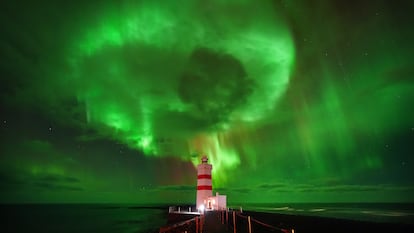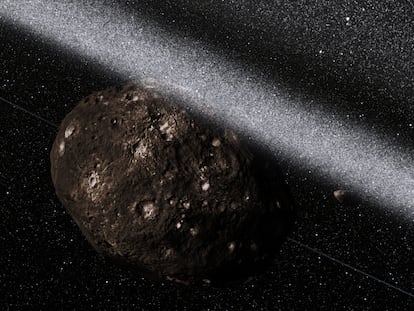Mysterious song from outer space discovered
Chorus waves, which affect the safety of astronauts and satellites, have been found in a place where their existence was thought impossible
In the 1960s, scientists at the Halley Research Station in Antarctica began hearing mysterious waves originating over the Earth’s equator. Their radio receivers were picking up intense bursts of electrons shaking the magnetosphere, the layer created by Earth’s magnetic field that protects life from space radiation. When these signals were converted into sound, they produced a whistling sound that could be mistaken for the chirping of birds at dawn.
Later, it was discovered that this chorus is also heard on Saturn and Jupiter, and it was thought that it was governed by the magnetic field generated by the planets between their poles. The origin of this spatial trill is usually found close to them, in the case of Earth less than 51,000 kilometers (31,690 miles) above its surface. Now, a team has published a study in the journal Nature, the results of which suggest that it can also be located much further away, in deep space. At least 160,000 kilometers away (99,419 miles).
“For more than 70 years, scientists have believed that chorus waves can only be generated in regions close to planets where a dipolar magnetic field is present, which has been proposed as the key factor controlling the generation and propagation of chorus waves,” explains Chengming Liu, a researcher at the School of Earth and Space Sciences at Beihang University in Beijing, China, and one of the leaders of the study. “In our paper, we present an unexpected observation of chorus waves far from Earth, where a dipolar magnetic field is absent, and reveal a fundamental mechanism for chorus wave generation, which can operate anywhere in space.”
The discovery is of scientific interest, but also of practical interest. Chorus waves can cause radiation that is dangerous for astronauts or satellites, and knowing in detail how they are produced would allow us to predict their occurrence and apply protective measures. “Chorus waves are some of the most intense waves in space. They can accelerate electrons to ultra-high energies and therefore cause radiation that affects humans and electromagnetic devices on spacecraft,” explains Liu. “Just as we worry about rain and wind on the Earth’s surface, we should worry about space weather in space,” he points out.
The most widely accepted theory for the formation of chorus waves is that they are caused by what is known as a plasma instability. Electrons trapped in the Earth's magnetic field, which make up the plasma, usually move in an orderly, spiraling fashion around the magnetic field lines. But every now and then that order is disrupted. The motion of the electrons generates electromagnetic chorus waves, which spin in the same direction as the particles. And when the waves and electrons have the same frequency and spin at the same rate, a resonance occurs, and the waves transfer energy to the electrons. This common impulse accelerates the electrons and generates the bursts of plasma waves that pass through the Earth's magnetic field and sound like birds at dawn when the radio signal is converted into sound.
The detection of this distant signal — on the side opposite the Sun, where the push of the stellar wind stretches and distorts the magnetosphere — occurred in 2019 thanks to NASA’s quartet of MMS (Multiscale Magnetospheric Mission) satellites. In the information collected by the satellite, the team led by Liu and Jinbin Cao found waves that lasted a tenth of a second and quickly went from a low frequency to a high frequency, as happens with the chorus waves observed closer to Earth. For the authors, this indicates that the formation process may be similar in both regions, although the environment is different, and that the waves could form anywhere in space, as long as the right conditions were present.
Knowledge of chorus waves, in addition to bringing us closer to the mechanisms that govern the cosmos and revealing the origin of the mysterious whistling sounds that were first heard at the Halley Research Station, has practical applications. Better understanding how they are generated and propagated can help make space travel safer for astronauts. At the moment, prolonged exposure to space radiation is one of the main obstacles to a manned trip to Mars. These whistling waves are also related to the way electrons scatter through the atmosphere to form diffuse, pulsating auroras, and understanding their nature can be useful in mitigating the effects of these storms on Earth’s communication and energy networks.
In space, this phenomenon also explains the acceleration of electrons in the radiation belts surrounding our planet, something that affects the safety of satellites. “Our research reveals that the excitation of these fluctuations arises from a fundamental physical mechanism and once we understand how they are generated, we can try to control their production, thus preventing them from posing risks to astronauts and satellites,” says Liu. “For example, we discovered that the excitation of these fluctuations is related to a particular motion of electrons, specifically the electron holes mentioned in the article. If we manage to fill these electron holes, it will be harder for these fluctuations to be excited, allowing us to limit their generation. This approach is somewhat similar to how we prevent rain on Earth through human intervention,” concludes Liu.
Sign up for our weekly newsletter to get more English-language news coverage from EL PAÍS USA Edition
Tu suscripción se está usando en otro dispositivo
¿Quieres añadir otro usuario a tu suscripción?
Si continúas leyendo en este dispositivo, no se podrá leer en el otro.
FlechaTu suscripción se está usando en otro dispositivo y solo puedes acceder a EL PAÍS desde un dispositivo a la vez.
Si quieres compartir tu cuenta, cambia tu suscripción a la modalidad Premium, así podrás añadir otro usuario. Cada uno accederá con su propia cuenta de email, lo que os permitirá personalizar vuestra experiencia en EL PAÍS.
¿Tienes una suscripción de empresa? Accede aquí para contratar más cuentas.
En el caso de no saber quién está usando tu cuenta, te recomendamos cambiar tu contraseña aquí.
Si decides continuar compartiendo tu cuenta, este mensaje se mostrará en tu dispositivo y en el de la otra persona que está usando tu cuenta de forma indefinida, afectando a tu experiencia de lectura. Puedes consultar aquí los términos y condiciones de la suscripción digital.
More information
Archived In
Últimas noticias
The murder of Michele and Rob Reiner: A tale of horrific days in Hollywood
Trump orders a ‘complete blockade of sanctioned oil tankers’ going to and from Venezuela
Not all insomnia is the same: Study identifies five subtypes and paves the way for personalized treatment
The United States designates Clan del Golfo as a foreign terrorist group
Most viewed
- ‘El Limones’ and the growing union disguise of Mexican organized crime
- Christian Louboutin: ‘Young people don’t want to be like their parents. And if their parents wear sneakers, they’re going to look for something else’
- ‘We are dying’: Cuba sinks into a health crisis amid medicine shortages and misdiagnosis
- A mountaineer, accused of manslaughter for the death of his partner during a climb: He silenced his phone and refused a helicopter rescue
- The low-cost creative revolution: How technology is making art accessible to everyone












































